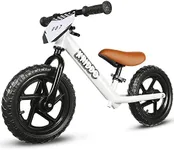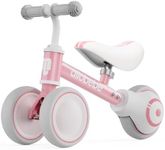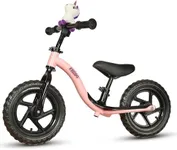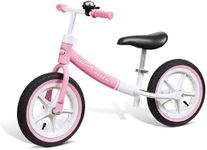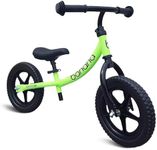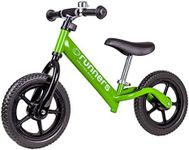Buying Guide for the Best Balance Bike For Toddlers
Choosing a balance bike for toddlers is an exciting step in helping your child learn to ride. Balance bikes are designed to teach young children how to balance and steer without the need for training wheels. The right bike can make learning fun, safe, and comfortable, so it's important to consider a few key features that will match your child's size, ability, and interests.Wheel SizeWheel size refers to the diameter of the bike's wheels, usually measured in inches. This is important because it affects how well the bike fits your child and how easy it is for them to control. Most balance bikes for toddlers have wheels between 10 and 14 inches. Smaller wheels (10-12 inches) are best for younger or shorter toddlers, making it easier for them to reach the ground and handle the bike. Larger wheels (14 inches) are better for taller or older toddlers, offering a smoother ride over bumps. To pick the right size, check that your child can sit on the seat with both feet flat on the ground.
Frame MaterialThe frame material determines the bike's weight, durability, and sometimes its appearance. Common materials include metal (steel or aluminum), wood, and sometimes plastic. Metal frames are sturdy and long-lasting, with aluminum being lighter and easier for small children to handle. Wooden frames are eco-friendly and have a classic look, but may not be as adjustable or durable as metal. Plastic frames are very lightweight but may not hold up as well over time. Choose a material that balances durability and weight, making sure your child can easily lift and maneuver the bike.
Seat Height AdjustabilitySeat height adjustability means you can raise or lower the seat to fit your child as they grow. This is important because a proper fit helps your child feel confident and safe. Some bikes have fixed seats, while others offer a wide range of adjustment. If you want the bike to last through growth spurts or be shared between siblings, look for a model with a seat that can be easily adjusted without tools. Make sure the lowest seat height allows your child to sit with their feet flat on the ground.
Weight of the BikeThe weight of the balance bike affects how easy it is for your toddler to handle, push, and pick up the bike. Lighter bikes are easier for small children to control and less tiring to use, while heavier bikes may be more stable but harder to maneuver. As a general rule, the bike should not weigh more than about 30% of your child's body weight. Consider your child's strength and confidence when choosing a bike's weight.
Tires (Air vs. Foam)Balance bikes come with either air-filled (pneumatic) tires or solid foam tires. Air-filled tires provide better cushioning and grip, making them ideal for outdoor use on uneven surfaces. However, they can get punctures and require occasional maintenance. Foam tires are maintenance-free and lightweight, but they don't absorb bumps as well and may wear out faster on rough ground. If your child will mostly ride indoors or on smooth paths, foam tires are fine. For more adventurous outdoor use, air-filled tires are a better choice.
Handlebar and GripsThe handlebar and grips affect how comfortable and secure your child feels while steering. Look for handlebars that are the right width for your child's shoulders and have soft, non-slip grips to prevent hands from slipping off. Some bikes offer adjustable handlebars, which can be helpful as your child grows. Make sure the grips have safety ends (rounded or flared) to protect your child's hands in case of a fall.




